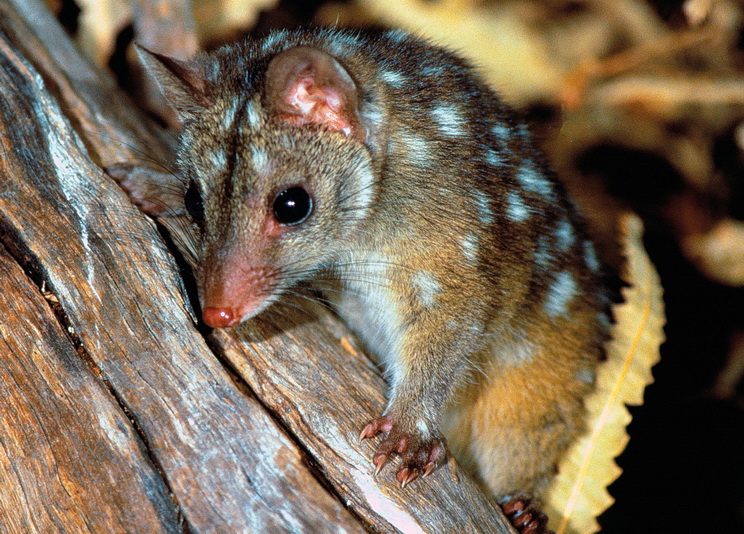By Tim Allard, CEO, and Dr Rod Kavanagh, Senior Ecologist
The ambitious project to create a feral predator-free area in the Pilliga State Conservation Area and Pilliga National Park (‘Pilliga’) and to reintroduce one of Australia’s most iconic threatened species into the area is on the verge of completion.
As this edition of Wildlife Matters goes to print, Australian Wildlife Conservancy (AWC) ecologists are in the final stages of preparing for the reintroduction of the first of six nationally threatened species – the Greater Bilby (Macrotis lagotis) – into a specially designed, feral predator-free area in the Pilliga. This will be the first time Bilbies have been seen in a NSW national park for more than a century.
 © Wayne Lawler/AWC
© Wayne Lawler/AWC
As part of its Saving our Species program, the New South Wales government has engaged AWC to implement science and land management programs across 35,750 hectares of the Pilliga. This includes the construction of the feral predator-proof fence, creating an area into which AWC ecologists will reintroduce Bilbies, followed over time by Western Barred Bandicoots, Bridled Nail-tail Wallabies, Brush-tailed Bettongs, Plains Mice, and Western Quolls. It will also protect extant mammal species including the Eastern Pygmy Possum and Pilliga Mouse, and bird species including Bush Stone Curlew and Speckled Warbler.
 © Brad Leue/AWC
© Brad Leue/AWC
The AWC team, led by Pilliga Operations Manager Wayne Sparrow, constructed the 32.2 kilometre fence using 6,500 steel pickets, 100 kilometres of netting, 290 kilometres of plain wire and over 100,000 clips that secured the netting to the fence to create a 5,800 hectare protected area.
The team has also constructed an additional 3.9 kilometre fence to establish a 680 hectare breeding zone within the main feral predator-proof area where reintroduced species from different locations can be temporarily placed to ensure improved genetic diversity among the populations before they are released into the larger feral predator-free area.
 © Lochman Transparencies/AWC
© Lochman Transparencies/AWC
Following the completion of the fence, a comprehensive and intensive feral animal eradication campaign was launched targeting feral cats and foxes, as well as goats, feral pigs and rabbits. This has involved the deployment of an array of remote camera traps (totalling 11,370 camera trap nights). Throughout the campaign the team has successfully removed 975 goats, three cats and a number of foxes from the Pilliga.
In late November and early December, AWC ecologists will reintroduce Bilbies sourced from AWC’s population at Scotia Wildlife Sanctuary, in far western NSW, and from Thistle Island, off the South Australian coast.
A core part of AWC’s project is our long-term strategy to release mammals beyond the fence, once it is safe to do so. To do this successfully, feral predator levels must be known and controlled (or suppressed) to a low enough level to allow the native species to establish viable populations beyond the fence. AWC ecologist Dr Andrew Carter has been undertaking a ground-breaking research project into the ecology of cats and foxes at AWC’s Scotia Wildlife Sanctuary to develop a framework for assessing the population density of these predators. This work will be repeated and tested in the Pilliga forest environment so that AWC can have confidence in its beyond-the-fence strategy.
 © Kim Wormald
© Kim Wormald
AWC’s Pilliga ecology team, led by Senior Ecologist Dr Rod Kavanagh, completed nearly three years of intensive baseline monitoring of the existing flora and fauna throughout the Pilliga prior to fence construction. In 2017-2018, the total annual survey effort was:
 © Wayne Lawler/AWC
© Wayne Lawler/AWC
AWC’s Pilliga ecology team has also completed its four- week, spring 2018 bird survey. Despite the extremely dry conditions across the state, the team recorded each of the threatened bird species known from the area, apart from Glossy Black Cockatoos. Across the bird monitoring sites, the team confirmed Eastern Grey-crowned Babblers at four sites, South-eastern Brown Treecreepers at five sites, Flame Robins at one site, Speckled Warblers at six sites and Varied Sittellas at 10 sites. Honeyeater sightings were low in the absence of any significant flowering, but Painted Honeyeaters were recorded at two of the sites. The survey wrapped up with a rare sighting of two Yellow-tailed Black Cockatoos feeding in Belah trees. During nocturnal surveys in September, Barking Owls were recorded at 10 sites.
At the project’s second site, Mallee Cliffs National Park in south-western NSW, AWC is finalising the assessment and approvals for construction of a 37.2 kilometre feral-proof fence, protecting 9,570 hectares within this 58,000 hectare reserve.